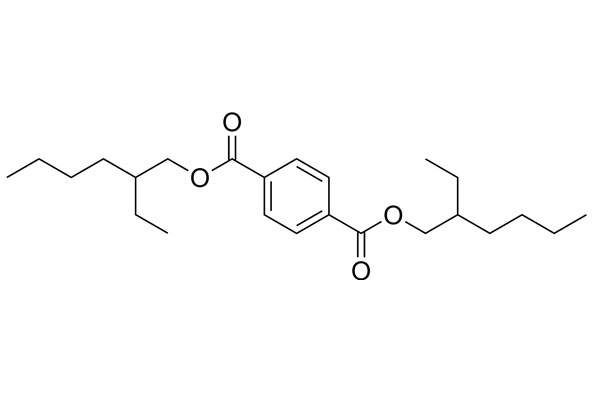Cas No: 6422-86-2
EINESC No: 229-176-9
Molecular weight: 390,564 g/mol
Chemical Formula: C24H38O4
Chemical Structure:
Physical Properties
General Properties: colorless, oily liquid
Odor: odorless
Intensity: 0,98 g/cm3
Boiling point: 400°C
Melting point: 30 ° C
Flash point: 110°C
Vapor pressure: 1 mmHg (20 ° C)
Refraction index: 1.49 nD
Solubility: almost indissoluble
Viscosity:

General Properties
Dioctyl terephthalate, or DOTP, is an ester of terephthalic acid and 2-ethyl hexanol. Although its properties are similar to DOP and DINP, it is a terephthalate and its structure is different from orthophthlates such as DOP and DINP.
DOTP is insoluble in water. It is a light-scented, luminous and colorless liquid. It is a good alternative as a plasticiser as it has similar toxicity and properties to DOP. Its usage is growing bigger as it has relatively low volatility.
Production
DOTP can be produced via two methods. One is trans-esterification of dimethyl terephthalate and 2-ethylhexanol.
Second is direct esterification of terephthalic acid and 2-ethylhexanol.
Applications
DOPT is most commonly used as plastifier for PVCs and it can be used as substitute for other phthalates. It is also commonly used in dye and varnish productions.
It is used in many other fields such as high-temperature cables, automotive plastic components and leather manufacturing. It is commonly used in calendering processes. It is patented for usage in extrusion, moulding, coating, various inks and latex compound production.
Safety Measures and Toxic Values
DOPT’s effects on humans are still a matter of research. It is considered as a safe chemical due to its low toxicity and carciogenic values compared to DOP. However, recent studies suggest that it may be suspected to be carciogenic for humans. DOPT is almost never disintigrates in nature and it is extremely dangerous for natural life. It also cumulates in water and soil. Therefore, it should not be given to city network unless necessary procedures are performed.